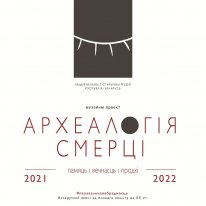ARCHAEOLOGY OF DEATH: MEMORY. ETERNITY. ANCESTORS
- 30.12.2020
The project “ARCHAEOLOGY OF DEATH: MEMORY. ETERNITY. ANCESTORS” begins at the National Historical Museum of the Republic of Belarus. It is dedicated to the funeral rituals on the Belarusian land from the late Neolithic to the 12th century. Funerary complexes of different eras tell the visitors how people's ideas about the afterlife, the veneration of the dead and the body handling of the deceased have changed. The project is based on research materials of ancient grave goods stored in the collection of the National Historical Museum of the Republic of Belarus, as well as on materials provided by the Institute of History of the National Academy of Sciences of Belarus and the Educational Laboratory of Museum Studies of the Faculty of History of Belarusian State University.
People’s attitude to death has changed with the development of human history. Every person, regardless of one’s religious and other views on the world, is interested in the finiteness of earthly life. Therefore, reflections on death in some modern societies occupy an important place in person's perception of one’s place in the world. They also form meanings of human existence to some extent.
Analysis of funeral rituals plays an important role in the study of scientific problems associated with the history of humankind, especially in preliterate times. Burials and grave goods as a reflection of the “culture of death” in some cases are the only source of information about certain archaeological culture. With the help of the material of the grave goods, one can reconstruct the costume of the buried people and, in general, its ideas about the afterlife. Knowledge of burial traditions makes it possible to study the issues of the genesis and historical and cultural fate of the bearers of archaeological cultures in the most effective way.
Not only can one learn about the spiritual life of ancient societies through the study of funeral rituals but also understand the features of their socio-political organization, trace intercultural ties and the circumstances of economic life. Museum project “ARCHAEOLOGY OF DEATH: MEMORY. ETERNITY. ANCESTORS” is the cycle of exhibitions that change throughout the year. It was implemented within the framework of a large project “The Past Has a Future: Dialogue of Culture and Science” aimed at popularizing archaeology among the general public and acquainting visitors with the work of an archaeologist.
The cycle begins with a Late Neolithic burial (the burial dates back to the second half of the 3rd millennium AD), which was discovered at the settlement of Drazdy-12 (Stowbtsy District of Minsk Region) during the expedition of the Faculty of History of Belarusian State University in 2014. The burial reflects the corresponding traditions of different late Neolithic cultures.
For visitors
opening hours
Open: 11.00–19.00
Daily
Ticket desk open: 11.00 – 18.30
Visitors enter: 11.00 – 18.30
admission
Adults:
Permanent exhibitions tour –
Br 10 BYN
Guided tour –
Br 30 BYN
Full-time students:
Permanent exhibitions tour –
Br 8 BYN
Guided tour –
Br 25 BYN
Schoolchildren and specialised secondary school students:
Permanent exhibitions tour –
Br 5 BYN
Guided tour –
Br 15 BYN
Retirees:
Permanent excibitions tour – 5 BYN
Guided tour – 15 BYN
Contacts
12 Vulica Karla Marksa, Minsk, 220030, Republic of Belarus
+375 17 3237665
+375 17 3748322
+375 17 3654827
histmuseum@histmuseum.by
Scientific department
office@histmuseum.by
Museum reception









